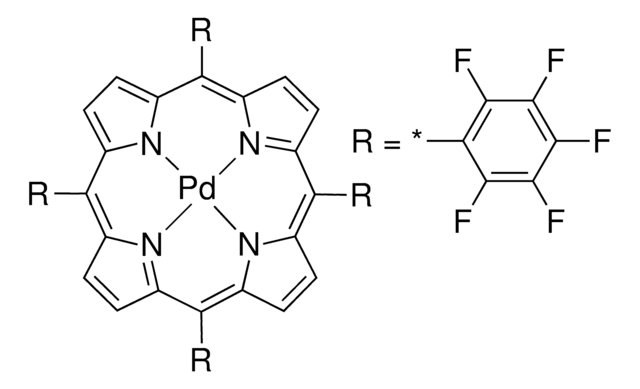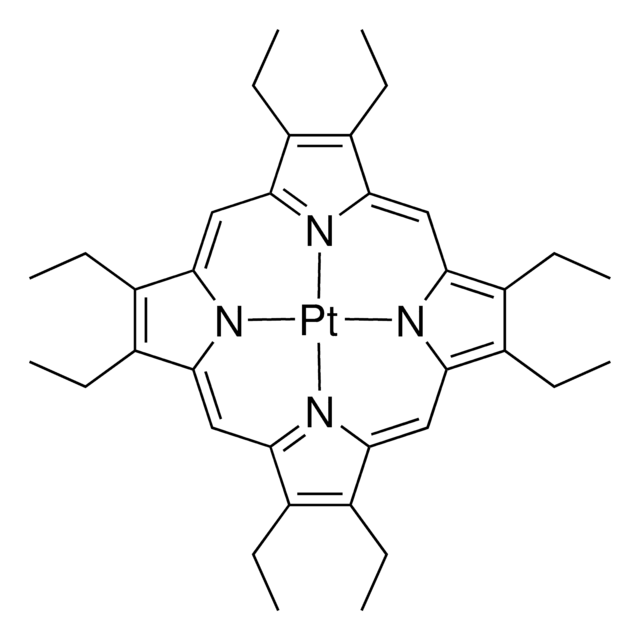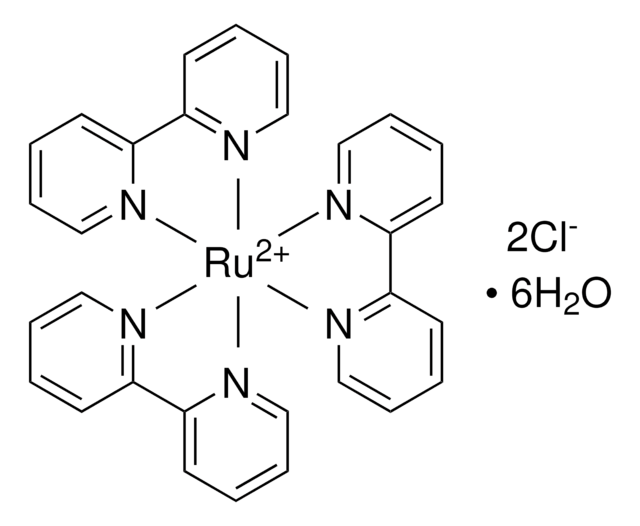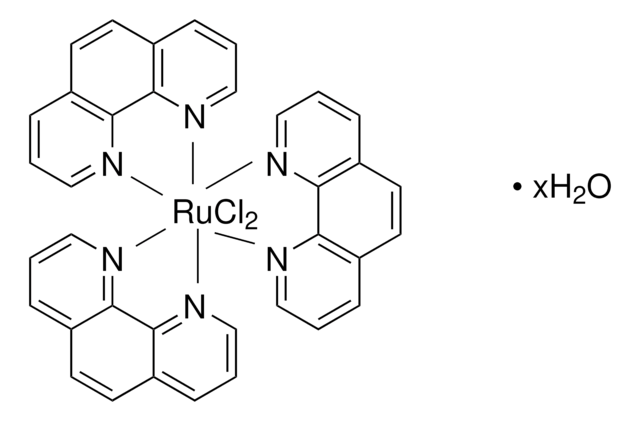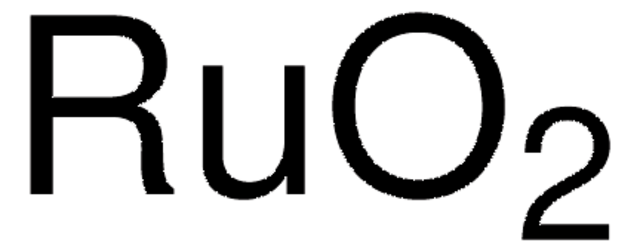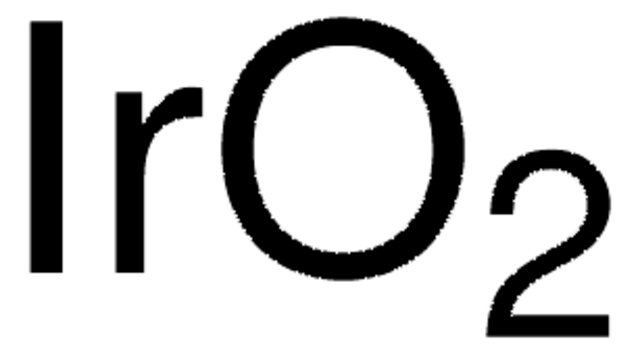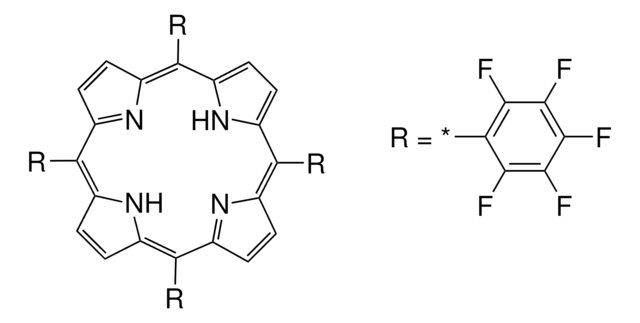76886
Tris(4,7-diphenyl-1,10-phenanthroline)ruthenium(II) dichloride complex
for fluorescence
Synonym(s):
Ru(ddp)
About This Item
Recommended Products
grade
for fluorescence
Assay
≥95% (HPCE)
form
powder
solubility
DMF: soluble
chloroform: soluble
ethanol: soluble
methanol: soluble
fluorescence
λex 455 nm; λem 610-630 nm in 0.1 M phosphate pH 7.0
SMILES string
Cl[Ru]Cl.c1ccc(cc1)-c2ccnc3c2ccc4c(ccnc34)-c5ccccc5.c6ccc(cc6)-c7ccnc8c7ccc9c(ccnc89)-c%10ccccc%10.c%11ccc(cc%11)-c%12ccnc%13c%12ccc%14c(ccnc%13%14)-c%15ccccc%15
InChI
1S/3C24H16N2.2ClH.Ru/c3*1-3-7-17(8-4-1)19-13-15-25-23-21(19)11-12-22-20(14-16-26-24(22)23)18-9-5-2-6-10-18;;;/h3*1-16H;2*1H;/q;;;;;+2/p-2
InChI key
SKZWFYFFTOHWQP-UHFFFAOYSA-L
Application
Packaging
Storage Class Code
13 - Non Combustible Solids
WGK
WGK 3
Flash Point(F)
Not applicable
Flash Point(C)
Not applicable
Personal Protective Equipment
Regulatory Information
Choose from one of the most recent versions:
Certificates of Analysis (COA)
It looks like we've run into a problem, but you can still download Certificates of Analysis from our Documents section.
If you need assistance, please contact Customer Support.
Already Own This Product?
Find documentation for the products that you have recently purchased in the Document Library.
Which document(s) contains shelf-life or expiration date information for a given product?
If available for a given product, the recommended re-test date or the expiration date can be found on the Certificate of Analysis.
How do I get lot-specific information or a Certificate of Analysis?
The lot specific COA document can be found by entering the lot number above under the "Documents" section.
What is the appearance of Tris(4,7-diphenyl-1,10-phenanthroline)ruthenium(II) dichloride complex (Rubidium-tris), Product 76886, supposed to be?
Product No. 76886 is an orange solid.
What are some applications for Tris(4,7-diphenyl-1,10-phenanthroline)ruthenium(II) dichloride complex (Rubidium-tris), Product 76886?
This product is widely used 1) as a probe for luminescent detection, 2) for quantitation of oxygen using (fiber) optic sensors[1,2], 3) studies on oxygen in skin [3,4].
In what solvents is Tris(4,7-diphenyl-1,10-phenanthroline)ruthenium(II) dichloride complex (Rubidium-tris), Product 76886, soluble?
It is soluble in DMF, chloroform, ethanol, methanol and toluene (moderately).
Do you have any information on the optical properties of the dye commonly known as Ru(dpp), Tris(4,7-diphenyl-1,10-phenanthroline)ruthenium(II) dichloride complex (Rubidium-tris), Product 76886?
We have the following information regarding solutions of this dye in toluene. The absorbance (excitation) maximum is at 455 nm, with a fluorescence (emission) maximum of 613 nm. The extinction coefficient of the visible maximum (~460 nm) is 30,000 M-1cm-1.
What is the O2 detection/determination limit of Tris(4,7-diphenyl-1,10-phenanthroline)ruthenium(II) dichloride complex (Rubidium-tris), Product 76886?
Unfortunately, we currently do not have such information available. Generally, this sensor dye's oxygen detection is based on quenching of its luminescence by oxygen. Its detection limit for oxygen in solution will be mainly depending on the intensity differences the used fluorimeter can detect.
What can be used with Tris(4,7-diphenyl-1,10-phenanthroline)ruthenium(II) dichloride complex (Rubidium-tris), Product 76886, for the fabrication of O2 sensor layers?
According to what we have found in the literature, asilicone polymer and polystyrene have both been used for sensor fabrication. See Klimant, I. and O.S. Wolfbeis, Analytical Chemistry, 67, 3160-3166 (1995) and references cited therein.
What are the recommended storage conditions for Tris(4,7-diphenyl-1,10-phenanthroline)ruthenium(II) dichloride complex (Rubidium-tris), Product 76886?
We recommend that this product be stored under an inert gas, such as argon. Avoid light, because it is light-sensitive.
How do I find price and availability?
There are several ways to find pricing and availability for our products. Once you log onto our website, you will find the price and availability displayed on the product detail page. You can contact any of our Customer Sales and Service offices to receive a quote. USA customers: 1-800-325-3010 or view local office numbers.
What is the Department of Transportation shipping information for this product?
Transportation information can be found in Section 14 of the product's (M)SDS.To access the shipping information for this material, use the link on the product detail page for the product.
My question is not addressed here, how can I contact Technical Service for assistance?
Ask a Scientist here.
Our team of scientists has experience in all areas of research including Life Science, Material Science, Chemical Synthesis, Chromatography, Analytical and many others.
Contact Technical Service![[Ru(phen)3]Cl2 ≥95%](/deepweb/assets/sigmaaldrich/product/structures/955/596/46f63eaa-39f8-4058-847d-cef0862ada92/640/46f63eaa-39f8-4058-847d-cef0862ada92.png)
